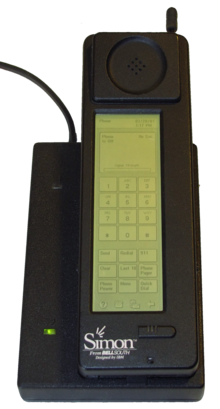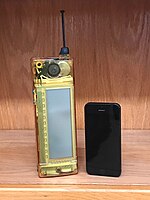IBM Simon
 The Simon Personal Communicator shown in its charging base | |
| Brand | BellSouth (designed by IBM) |
|---|---|
| Developer | IBM |
| Manufacturer | Mitsubishi Electric Corp. |
| Type | Smartphone |
| First released | 1994[1] |
| Availability by region | United States August 16, 1994 (BellSouth Cellular) |
| Discontinued | February 1995 |
| Units sold | 50,000 |
| Predecessor | Angler (code name) |
| Compatible networks | AMPS |
| Form factor | Brick |
| Dimensions |
|
| Weight | 18 oz (510 g) |
| Operating system | Datalight ROM-DOS |
| CPU | NEC V30HL, 16 MHz, 16-bit, 8086-compatible CPU as part of Vadem VG230 System on a chip |
| Memory | 1 MB PSRAM (2× Hitachi HM658512LTT) 32 KB SRAM (Sony CXK58257) |
| Storage | 1 MB NOR Flash (Intel/Hitachi) expanded to 2 MB by Stacker compression + 32KB BIOS NOR Flash |
| Removable storage | Optional PCMCIA Flash RAM cards |
| Battery | 7.5V NiCad |
| Display | 4.5 in × 1.4 in (114 mm × 36 mm), 160 × 293 pixel CGA monochrome backlit LCD |
| Connectivity |
|
| Data inputs |
|
| References | [2][1][3][4][5] |
The IBM Simon Personal Communicator (simply known as IBM Simon) is a handheld, touchscreen PDA designed by International Business Machines (IBM), and manufactured by Mitsubishi Electric.[6] Although the term "smartphone" was not coined until 1995, because of Simon's features and capabilities, it has been retrospectively referred to as the first true smartphone.[2][7][8][9]
BellSouth Cellular Corp. distributed the IBM Simon in the United States between August 1994 and February 1995, selling 50,000 units. The Simon Personal Communicator was the first personal digital assistant or PDA to include telephony features (make phone calls). The battery lasted only an hour, and flip phones became increasingly slim which led to its demise.[10]
History
[edit]
With advances in MOSFET (metal–oxide–semiconductor field-effect transistor, or MOS transistor) technology enabling smaller integrated circuit chips be powered[11] and the proliferation of wireless mobile networks,[12][13] IBM engineer Frank Canova realised that chip-and-wireless technology was becoming small enough to use in handheld devices.[14] IBM debuted a prototype device, code named "Sweetspot",[15] on November 16, 1992,[16][17] at the COMDEX[18] computer and technology trade show in Las Vegas, Nevada, United States. The Sweetspot prototype combined a mobile phone and PDA into one device, allowing a user to make and receive telephone calls, facsimiles, emails and cellular pages. Not only did the prototype have many PDA features including a calendar, address book and notepad, but also demonstrated other digital services such as maps, stocks and news before they were widely available. COMDEX show attendees and the press showed interest in the device. The day after Sweetspot's debut, USA Today featured a photo on the front page of the Money section showing Frank Canova, IBM's lead architect and inventor of the smartphone,[19][20] holding the Sweetspot prototype.[2][21][22]
After a very successful prototype demonstration at COMDEX, IBM began work on the commercial product, code named "Angler".[15] The IBM device was manufactured by Mitsubishi Electric, which integrated features from its own wireless personal digital assistant (PDA) and cellular radio technologies while building the IBM device. IBM initially approached Motorola to manufacture the product, but Motorola rejected the offer, concerned that IBM could become a potential rival mobile manufacturer. IBM then approached Mitsubishi to build the device.[6]
BellSouth executives gave the finished product its final name, "Simon Personal Communicator", before its public debut at the Wireless World Conference in November 1993.[2] BellSouth Cellular had planned to begin selling Simon in May 1994, but due to problems with the device's software, the Simon did not become available to consumers[23] until August 16, 1994. BellSouth Cellular initially offered the Simon throughout its 15-state service area for US$899 with a two-year service contract or US$1099 without a contract. Later in the product's life, BellSouth Cellular reduced the price to US$599 with a two-year contract.[citation needed]
BellSouth Cellular sold approximately 50,000 units during the product's six months on the market.[2]

Features
[edit]In addition to its ability to make and receive cellular phone calls, Simon was also able to send and receive faxes, e-mails and cellular pages. Simon featured many applications, including an address book, calendar, appointment scheduler, calculator, world time clock, electronic notepad, handwritten annotations, and standard and predictive stylus input screen keyboards.[24]
It features a liquid-crystal display (LCD) and has PC Card support.[25] Its internal hardware includes the Vadem VG230 (CMOS) system-on-a-chip (SoC) from NEC, MOS random-access memory (RAM) chips from Sony and Hitachi, flash memory (floating-gate MOS) chips from Intel and Hitachi, and Cirrus Logic modem chips.[5]
Accessories
[edit]Each Simon was shipped with a charging base station, a nickel-cadmium battery,[1] and a protective leather cover. Optional accessories included a PCMCIA pager card designed by Motorola, an RS-232 adapter cable for use with PC-Link to access files from a personal computer,[citation needed] and an RJ11 adapter cable to allow voice and data calls to be made over POTS landlines. The RJ11 adapter helped users reduce expensive cellular phone bills or make calls where cellular coverage didn't exist in 1994.[1]
Operating system and applications
[edit]The Simon used the file system from Datalight ROM-DOS along with file compression from Stacker. IBM created a unique touch-screen user interface for Simon; no DOS prompt existed.[1] This user interface software layer for Simon was known as the Navigator.[26]
The Simon could be upgraded to run third party applications either by inserting a PCMCIA card or by downloading an application to the phone's internal memory.[citation needed]
PDA Dimensions developed "DispatchIt", the only aftermarket, third-party application developed for Simon. It was an early predecessor to "Remote Desktop" software.[27] The DispatchIt application costs were US$2,999 for the host PC software and US$299 for each Simon software client.[28]
See also
[edit]References
[edit]- ^ a b c d e O'Malley, Chris (December 1994). "Simonizing the PDA". Byte. 19 (12): 145–148. ISSN 0360-5280. Archived from the original on February 21, 1999. Retrieved June 30, 2012.
The CPU is a 16-bit x86-compatible processor running at 16 MHz, a single-chip design manufactured by Vadem. Simon runs a version of DOS called ROM-DOS, from Datalight...
- ^ a b c d e Sager, Ira (June 29, 2012). "Before IPhone and Android Came Simon, the First Smartphone". Bloomberg Businessweek. ISSN 2162-657X. Archived from the original on July 1, 2012. Retrieved June 30, 2012.
Simon was the first smartphone. Twenty years ago, it envisioned our app-happy mobile lives, squeezing the features of a cell phone, pager, fax machine, and computer into an 18-ounce black brick.
- ^ "Bellsouth, IBM Unveil Personal Communicator Phone". Mobile Phone News. November 8, 1993. ISSN 0737-5077. Retrieved June 30, 2012.
The phone currently is based on an AMPS standard...
- ^ "BellSouth: IBM Simon PDA Cellphone". RetroCom. Retrieved June 30, 2012.
Graphic display: 160 x 293
- ^ a b Nochkin, Alexandr (July 10, 2013). "IBM Simon. The first smartphone in the World. What's inside". IBM blog (in Russian). Habrahabr.ru. Retrieved June 5, 2017.
- ^ a b Jin, Dal Yong (2017). Smartland Korea: Mobile Communication, Culture, and Society. University of Michigan Press. pp. 34–35. ISBN 9780472053377.
- ^ "Ericsson GS88 Preview". Eri-no-moto. 2006. Archived from the original on January 11, 2012. Retrieved December 15, 2011.
- ^ "Penelope Box". Stockholm Smartphone. 2010. Archived from the original on February 3, 2012. Retrieved December 15, 2011.
- ^ Savage, Pamela (January 1995). "Designing a GUI for Business Telephone users". Interactions. 2. Association for Computing Machinery: 32–41. doi:10.1145/208143.208157. S2CID 19863684. Retrieved September 13, 2014.
...It is at this point that early usability test participants met impasse. The switch connected to our "smart phone" is expecting the typical "dumb end-point"... AT&T's PhoneWriter was demonstrated at the 1993 Comdex Computer Show...
- ^ First Smartphone Turns 20: Fun Facts About Simon, 2014-08-18.
- ^ Sahay, Shubham; Kumar, Mamidala Jagadesh (2019). Junctionless Field-Effect Transistors: Design, Modeling, and Simulation. John Wiley & Sons. ISBN 9781119523536.
- ^ Baliga, B. Jayant (2005). Silicon RF Power MOSFETS. World Scientific. ISBN 9789812561213.
- ^ O'Neill, A. (2008). "Asad Abidi Recognized for Work in RF-CMOS". IEEE Solid-State Circuits Society Newsletter. 13 (1): 57–58. doi:10.1109/N-SSC.2008.4785694. ISSN 1098-4232.
- ^ Sager, Ira (June 29, 2012). "Before IPhone and Android Came Simon, the First Smartphone". Bloomberg.com. Bloomberg News. Retrieved August 18, 2019.
- ^ a b "Simon History". Simoneer. Retrieved June 4, 2020.
- ^ Schneidawind, John (November 17, 1992). "IBM's new PC visions: Personal Communications" (PDF). Reporter's Notebook. No. Business. USA Today. pp. 6B. Retrieved December 8, 2021.
- ^ Lewis, Peter H. (November 15, 1992). "Sound Bytes; Here Comes Comdex/Fall Again, With Thumbs Up (Published 1992)". The New York Times. ISSN 0362-4331. Retrieved February 26, 2021.
- ^ "COMDEX History". motobayashi.net. Retrieved February 26, 2021.
- ^ Woyke, Elizabeth (2014). The Smartphone. Anatomy of an industry. New York: The New Press. pp. 3–9. ISBN 978-1-59558-963-7.
- ^ "US Patent 5537608". Google. USPTO. Retrieved September 25, 2015.
- ^ Schneidawind, John (November 23, 1992). "Poindexter Putting Finger on PC Bugs; Big Blue Unveiling". USA Today. p. 2B. ISSN 0734-7456.
- ^ Bradner, Erin (July 21, 2011). "Are You an Innovation Giant?". Designing the User Experience at Autodesk. Autodesk. Archived from the original on February 2, 2012. Retrieved November 23, 2012.
- ^ "IBM's Plans to Ship Simon Put On Hold for Time Being". Mobile Phone News. April 4, 1994. ISSN 0737-5077. Archived from the original on April 27, 2008. Retrieved June 30, 2012.
Technical issues, resulting from the integration of Simon's cellular faxing capability, were discovered early in the manufacturing and development cycle as IBM's quality assurance testing was being conducted. IBM will hold up shipments of the device until the bugs are worked out.
- ^ Simon Says "Here's How!" – Users Manual (PDF). IBM. 1994. Part Number 83G9872. Archived (PDF) from the original on December 2, 2013. Retrieved July 29, 2013.
- ^ "Simon History". Simoneers. Retrieved April 13, 2022.
- ^ US patent 5537608, Brent A. Beatty; Francis J. Canova Jr. & Charles S. Lanier et al., "Personal communicator apparatus", issued July 19, 1996, assigned to International Business Machines Corporation
- ^ BellSouth Cellular Corporation (March 9, 1995). "Bellsouth Cellular Corp. Announces Dispatchit™ Software For Simon™ Commercially Available" (Press release). PR Newswire. Archived from the original on October 29, 2013. Retrieved November 22, 2013.
- ^ Polishuk, Paul, ed. (May 1995). "BellSouth Cellular Corp. Announces DispatchIt Software for Simon". Wireless Telecommunications Newsletter. 5 (5): 9–10. ISSN 1083-7779. Retrieved June 30, 2010.
BellSouth Cellular Corp. (BSCC) and PDA Dimensions...announced the commercial availability of DispatchIt, a work order field service application using Simon, BSCC's personal communicator.
- "Simon". Buxton Collection. Microsoft Corporation. 2012. Archived from the original on March 17, 2013. Retrieved November 23, 2012.
Simon is the first smartphone. It paved the way for the ones of today by introducing touch screens to phones.
- "Buxton Collection Sampler" (PDF). CHI 2011. ACM SIGCHI. 2011. p. 6. Archived from the original (PDF) on March 18, 2013. Retrieved November 23, 2012.
IBM / Bell South Simon Smartphone: First shown in 1993, this was the world's first so-called 'smart phone'.
- The $899 Prehistoric Predecessor to the iPhone (Web video). Bloomberg. June 28, 2012. Archived from the original (FLV) on July 7, 2012. Retrieved December 16, 2012.
Long before the smartphone revolution, IBM and BellSouth teamed up to build and sell the Simon Personal Communicator, a 1-pound, $899 mobile phone that ran apps and featured the first touch screen. It lasted just six months after being put on the market in the summer of 1994.

